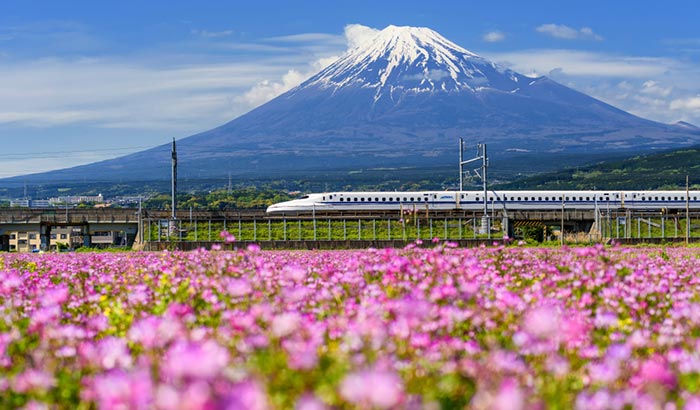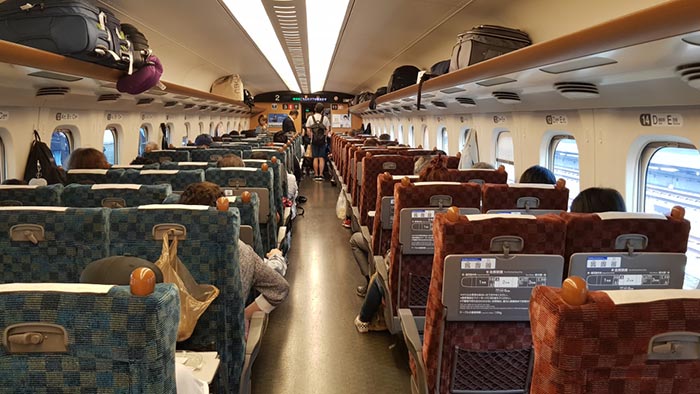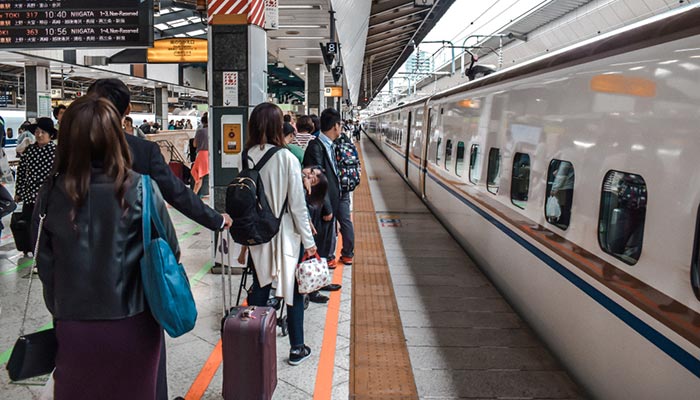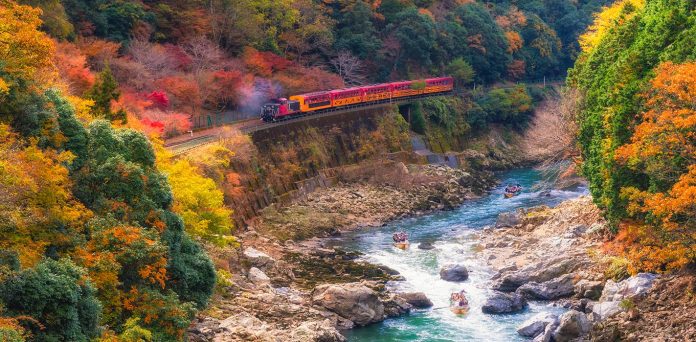When you think about traveling around Japan, probably the first thing to come to mind is the Bullet Train. Japan’s Bullet Train is, after all, renowned around the world for its speed and engineering ingenuity, so much so that many other countries base their own high-speed rail networks on Japan’s. Even though some countries have come close to achieving such an amazing railway network, none can ever truly rival that of Japan. So, when you’re visiting this incredible country in East Asia, be sure to travel by train at least once as it is, quite simply, the best way to get around Japan!
Is Taking the Train in Japan Safe?

Some countries in this part of the world do have a bad reputation for railway travel, with large numbers of derailments and collisions, but in Japan, this is not something you need to worry about. If we take the Bullet Train – officially named ‘Shinkansen’ – it has been operating for over 50 years and has a spectacular safety record. During this time, these trains have carried over 10 billion passengers and there have never been any fatalities due to train accidents, which is really quite surprising when you think that Japan is quite prone to natural disasters like earthquakes and typhoons. The Bullet Trains have an earthquake detection system that is able to stop the train very quickly, therefore limiting any potential problems that an earthquake may cause.
In addition to the safe operating of these trains, traveling around Japan by train is considered to be very safe, with little in the way of crime happening on the rail network. Of course, as with traveling around any country, there will always be petty thieves who may take their chances with an unsuspecting tourist, but if you keep your personal belongings close by and within your line of sight at all times, you should not have any problems with this.
If you’re a lady traveling alone and feel a little unsafe, be sure to look for a ladies-only car on a train. These are becoming more common but may not be available on all trains. You can be assured that any trains you ride in Japan will be clean, modern, comfortable and ultra-reliable when it comes to keeping to their schedules!
Types of Trains in Japan
While the Bullet Train is the one we all think about first, this is only one type of train out of many that operate in Japan. Here’s some information on all the different types of trains in Japan, starting with the Bullet Train.
Japan’s Bullet Train

The Shinkansen is a special express train which has some of its own rules and pricing structures; it is more expensive than other trains, but then that’s to be expected when you’re paying for the privilege of riding on a train that travels at speeds of up to 320 kilometers per hour (200mph)!
The Shinkansen is designed to rapidly get passengers from one big city to another, and the route is split into five different sections (operated by the five different JR – Japan Railway – companies) that cover a large majority of the country, and there are still expansions happening all the time. There’s actually quite a variety of different Shinkansen trains in operation as new ‘series’ have been introduced to replace older ones. Generally, the newer they are, the faster they go but speed does depend upon which lines they are operating on, and which routes they are running, as well as how many stops are scheduled.
Be aware that Shinkansen trains do not operate over night as the whole system shuts down between midnight and 6am so that nightly maintenance can occur, keeping the lines and the trains in tip-top condition. If you do want to book an overnight train, it will actually be running on an older narrow gauge line rather than on the Shinkansen line itself, so it won’t be a special express service.
Other Train Types in Japan

Japan Railways is the primary rail operator, with a number of lines that are all linked together to create the massive network across the country, and the good thing with traveling on any JR trains is that they are a number of different rail passes that you can buy which make traveling by train in Japan even more affordable.
As well as the JR services, there are also private operators. You’ll find these in most major cities, and to keep up with the competition from JR, these services are usually a little cheaper to make them more desirable. However, with those rail passes available, this difference in price becomes less of an issue.
If you’re traveling just a short distance, you’re more likely to be riding on a Local Train. These should stop at every station, so they are slow if you’re traveling a fairly long distance, but very useful for those shorter trips in and around cities.
Above the Local Trains there are several different types that are faster because they don’t stop at as many stations. There are some differences in names between these services across the various train operators, but generally you’ll see trains referred to as Rapid, Express, Limited Express, Commuter, and so on.
In some cities you can also ride on subways and light rail. These are an excellent way to get around cities quickly, and they often connect up with suburban railway lines if you want to venture a little further out of the city. Tokyo is the prime example for a subway system – it’s the largest in the country with 205 stations in total, but you’ll also find subway services in other cities, including Osaka, Sapporo, Nagoya, and Kyoto.
Where to Buy Your Tickets for Train Travel in Japan

As you would expect, you can buy tickets for train travel in Japan from the railway stations themselves. In the major stations you’ll usually have the option of using a touch-screen ticketing machine, many of which do have English language options to make life easier for non-Japanese speaking tourists. There are also manned booths in major JR stations where you can talk to somebody about where you want to go and find out what your options are. Staff usually speak good English here, so again there shouldn’t be a language barrier. For JR services this is called ‘midori-no-madoguchi’, but if you’re traveling on one of the private rail operators, they will have a different ticket window.
You can buy your tickets on the day of travel, but, it’s recommended to buy them in advance, if you can. This is especially true for traveling on weekends and on holidays, as trains can be completely full so if you didn’t book in advance you will have to wait for the next available train.
If you’re traveling on just one train in Japan, for example, going from Tokyo to Nagoya, then you’re probably better off buying a ticket that covers just that journey, so this would be a single trip ticket. You can buy these online using the travel website 12Go.asia, where the options for the different types/speeds of Shinkansen will all be shown on their search page, allowing you to choose the train you want, and the time you want to travel. This is a convenient way to get your Japanese train ticket in advance, but you will need pick up your ticket from Tokyo, or have them sent to you via EMS.
Japan Rail Pass

We should talk about the Japan Rail Pass as this is a great way to save money and adds convenience for travelers if you are planning to travel around Japan rather than just taking a single trip. The rail passes are available for 7, 14 and 21 day periods, and there are a variety of different rail passes available, depending on where you’re traveling. Interestingly, the Japan Rail Pass is only available for foreign passport holders, so it’s an incentive for foreign tourists to travel by train and it can give you excellent value for train travel in Japan. These do only cover the JP services though, as the private companies will have their own ticket options and passes, but with great coverage by Japan Rail, you should easily be able to get to anywhere you’d want to visit.
The passes give best value for money if you use them on the Shinkansen trains, but do be aware that they will not give you access to the fastest bullet trains. The JR Passes can also be bought online through 12Go, but, as with the regular tickets you will have to pick up your pass in person, or have it sent to you.
Excellent service, comfort levels, speed of travel, and the vastness of the railway network makes traveling by train in Japan something that is highly recommended. And, with the option to search for ticket types and train types online through 12Go, booking your tickets or passes in advance is very easy. Don’t miss our guide: Travel by Bus in Japan.
How useful was this post?
Click on a star to rate it!
Average rating / 5. Vote count:

